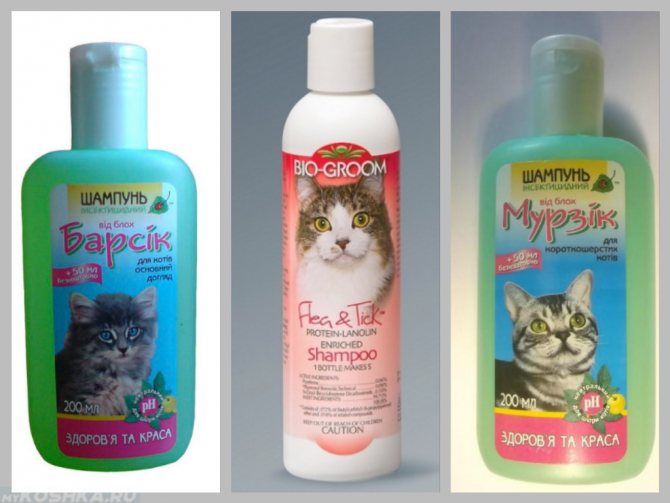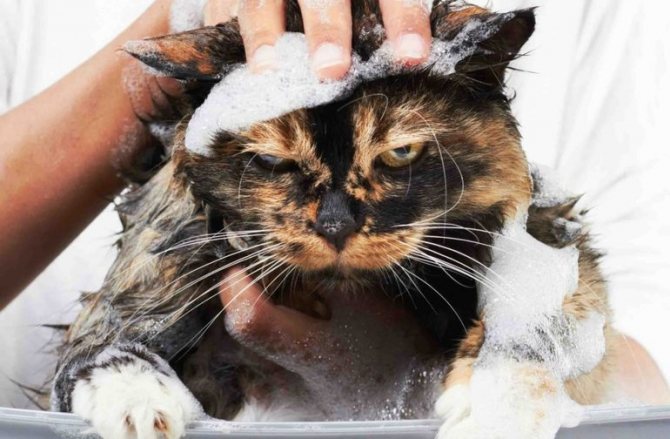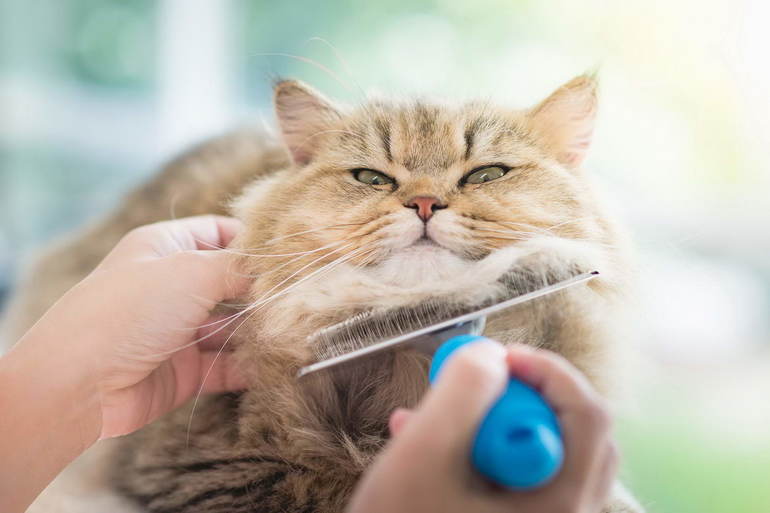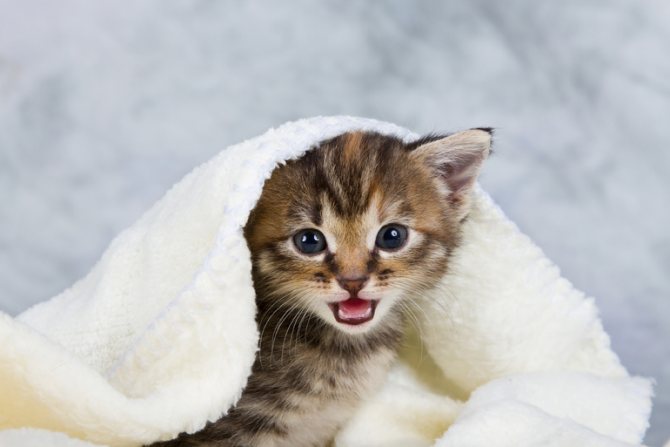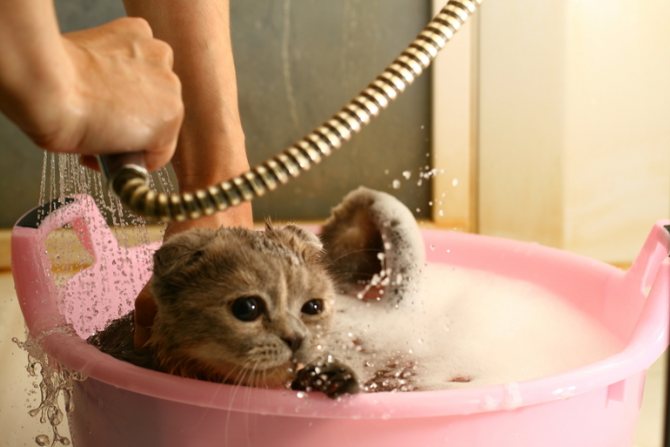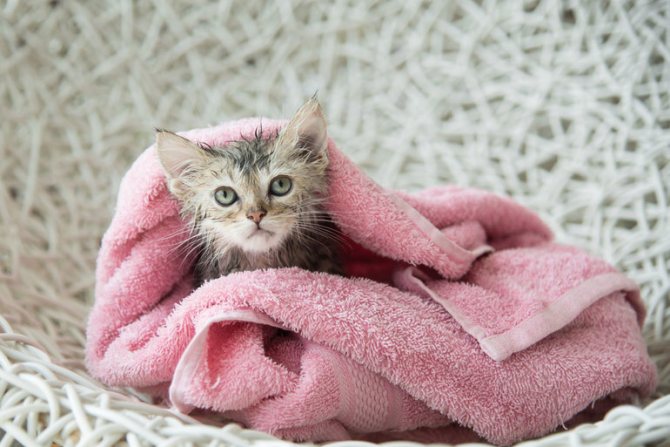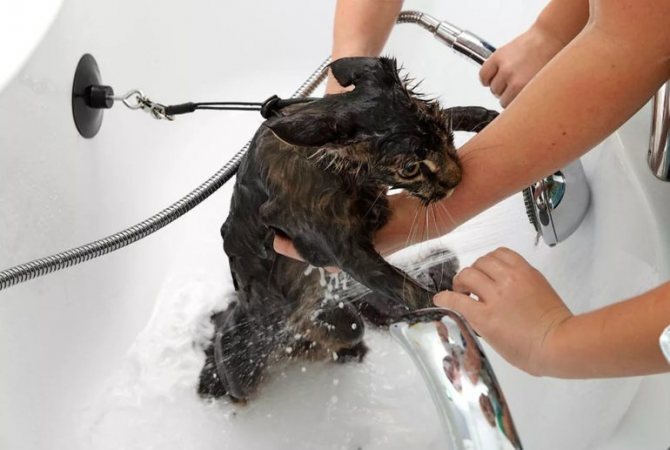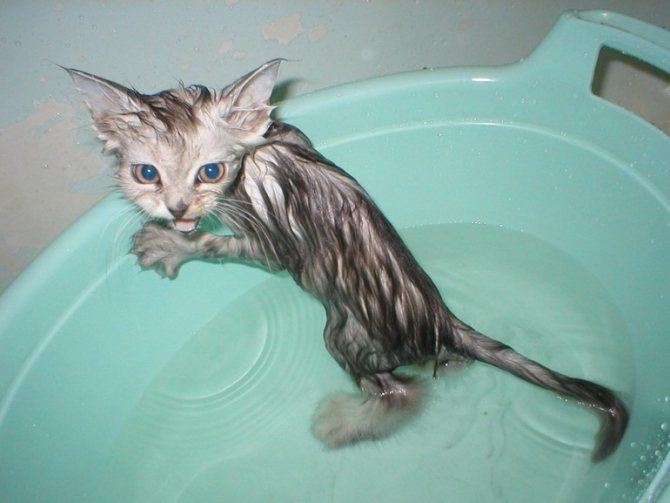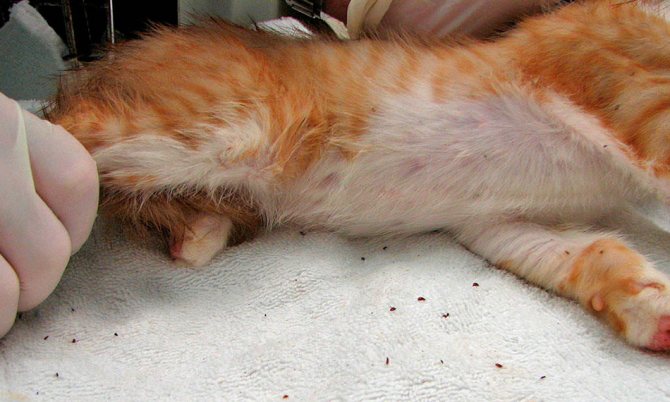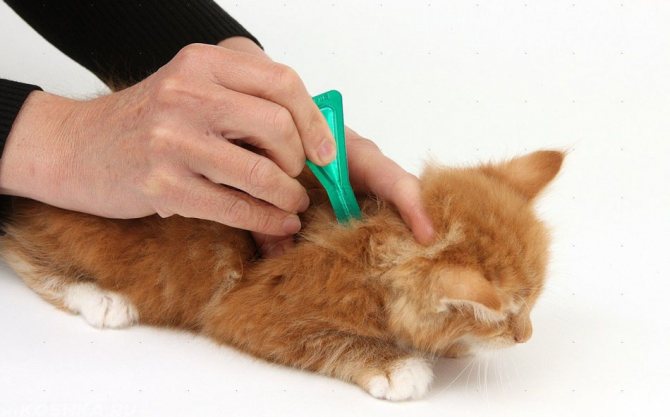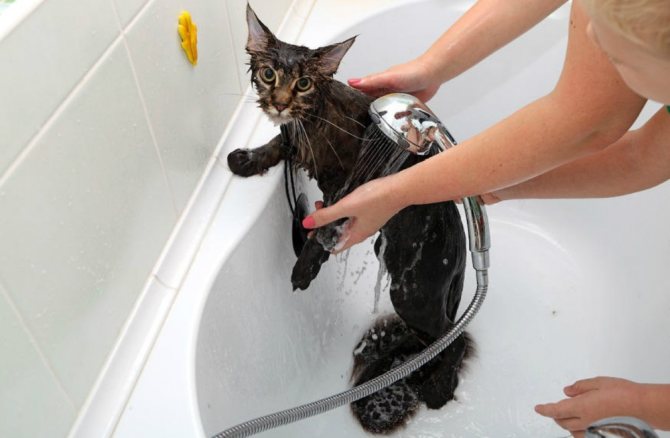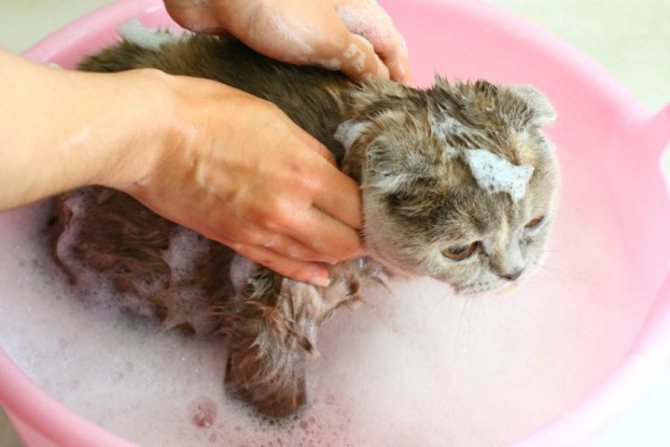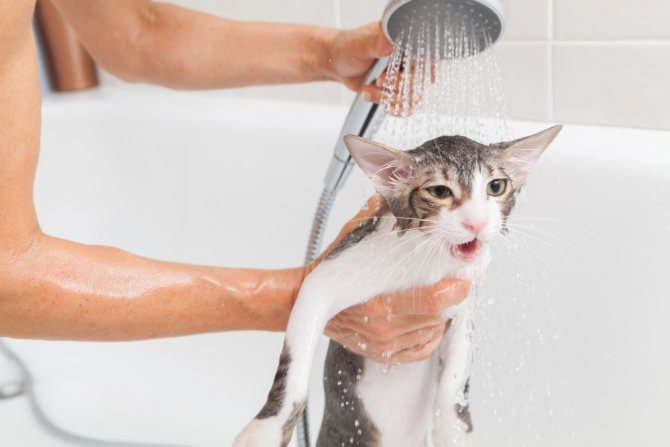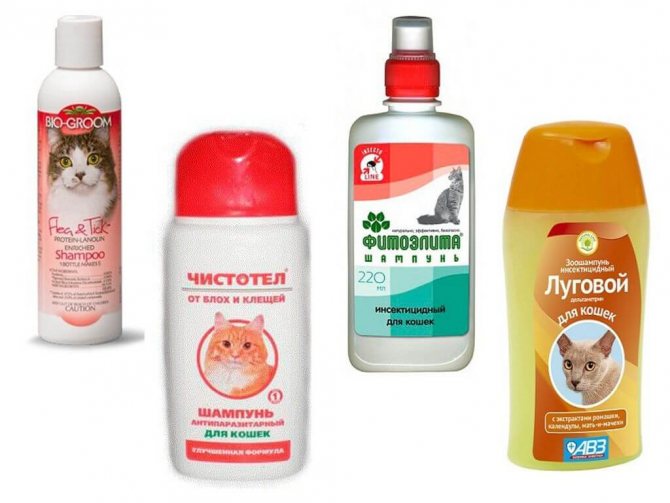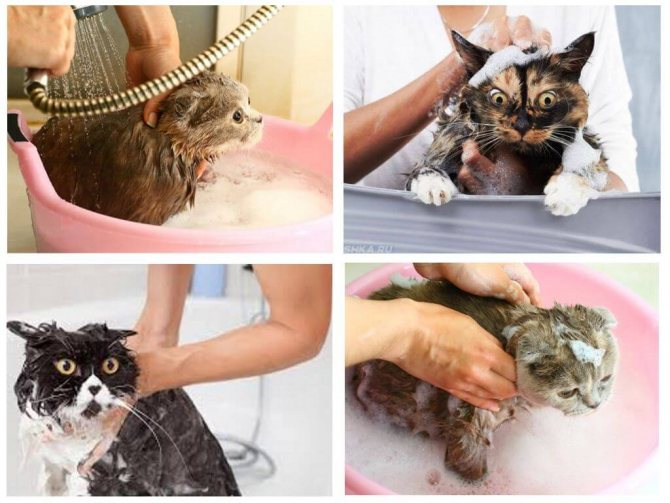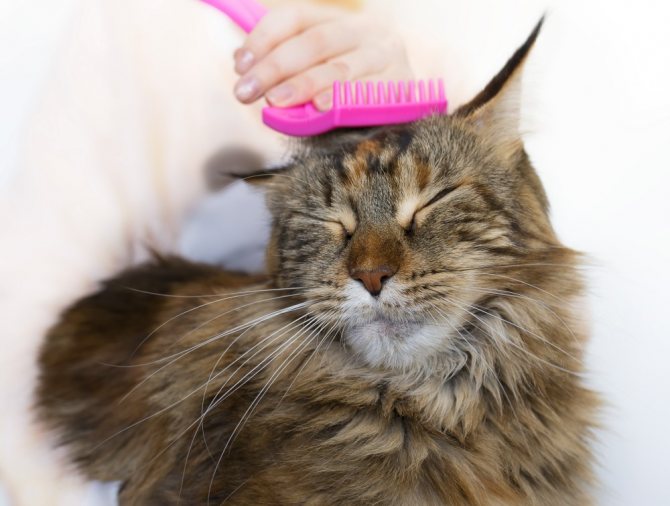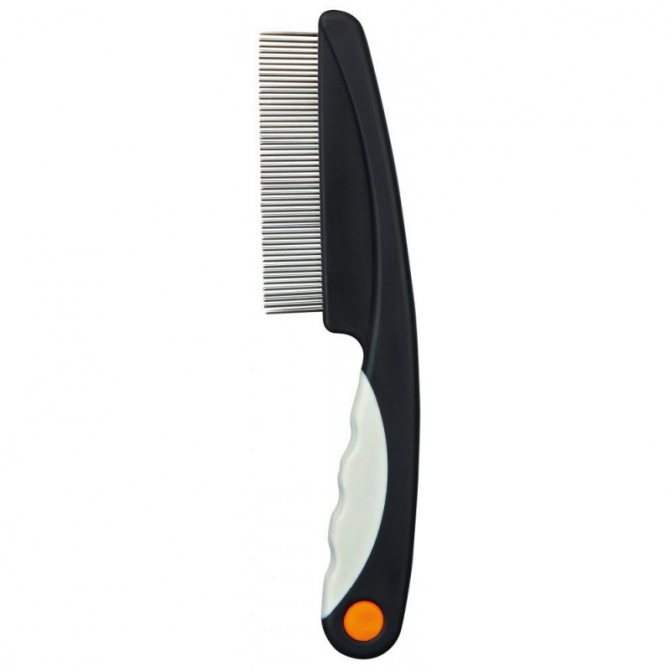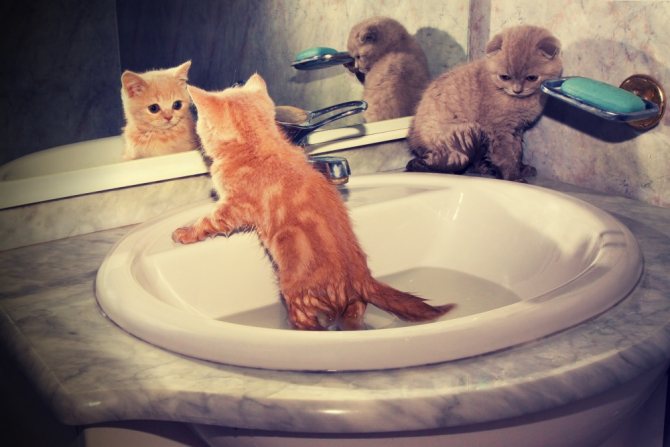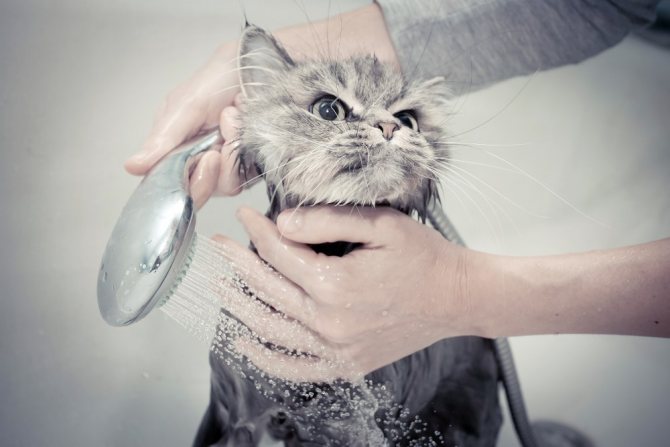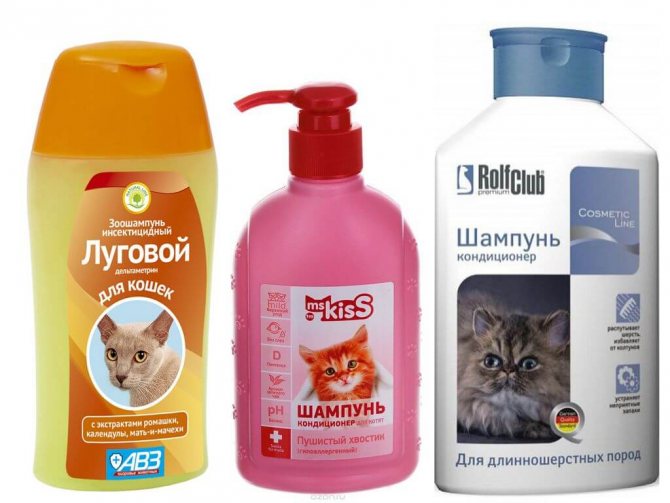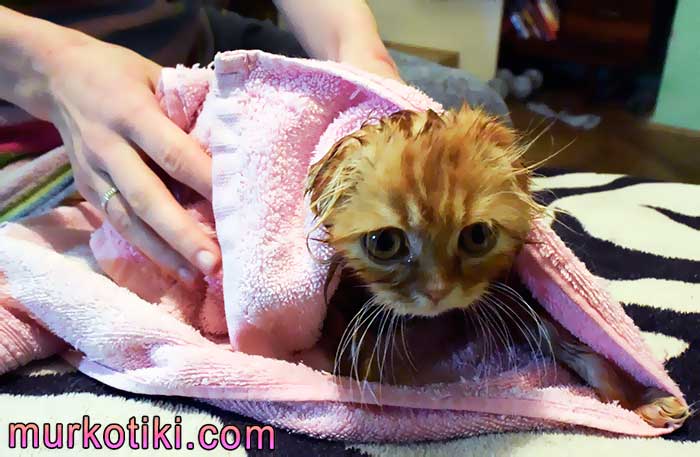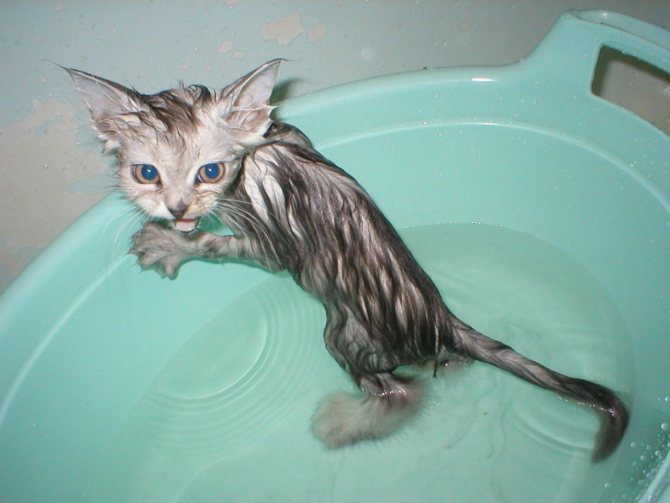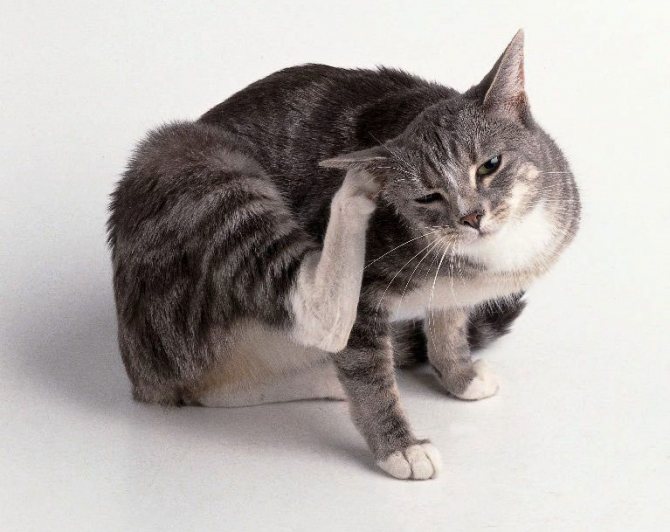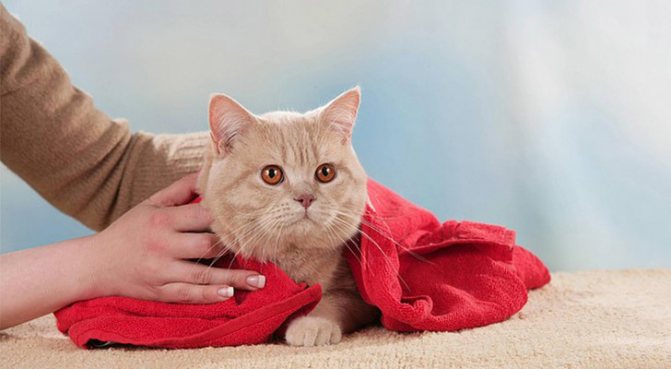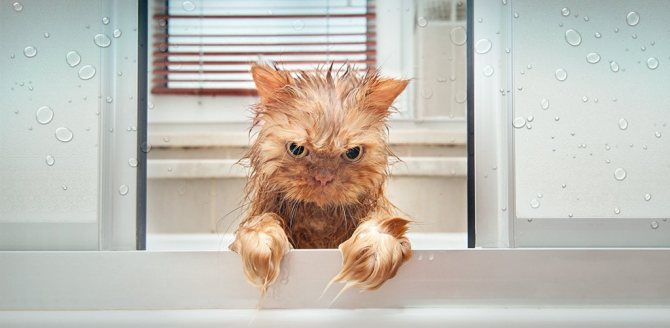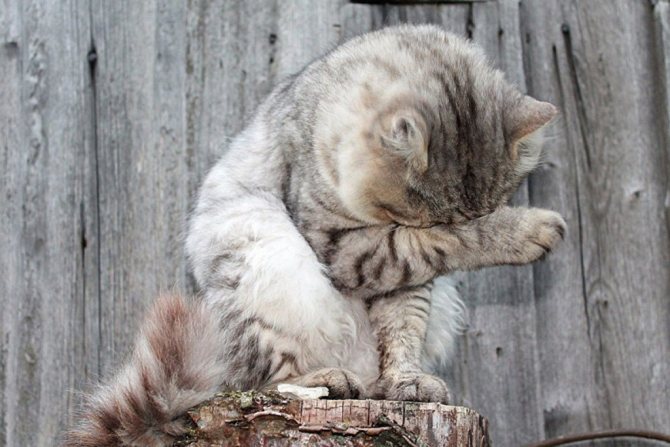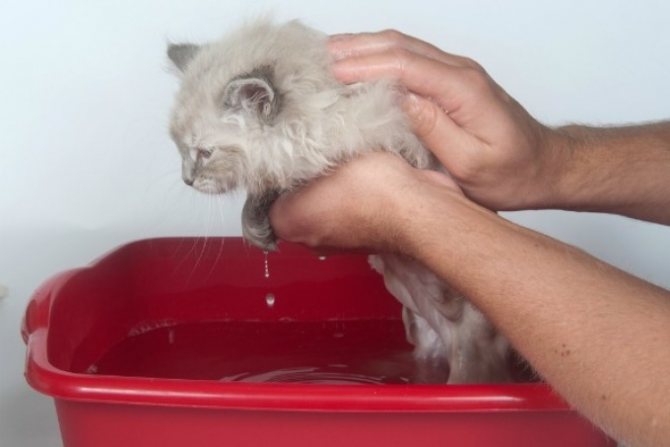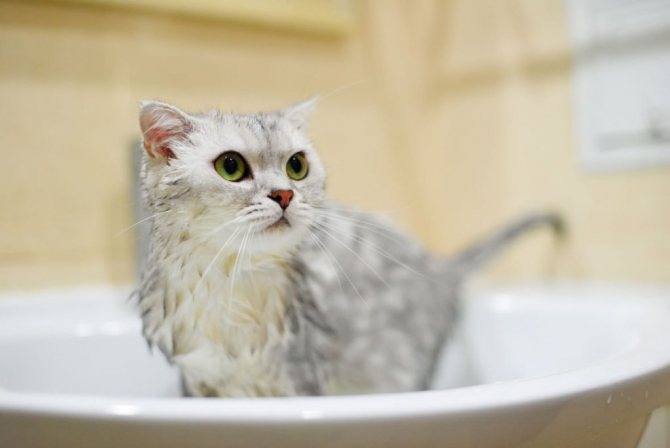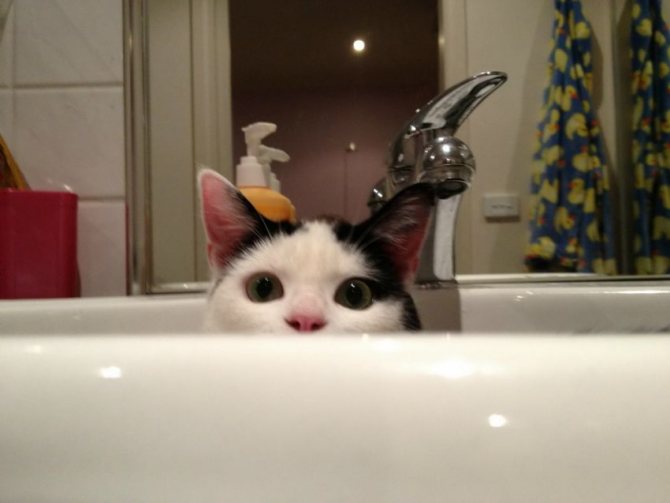Most cats avoid water treatments. However, this is one of the most important components of hygiene. How correctly the kitten is bathed for the first time depends on its attitude to water for many years. Therefore, it is necessary to take a responsible approach to this event: choose the right detergent, study the advice of felinologists and, of course, be patient.
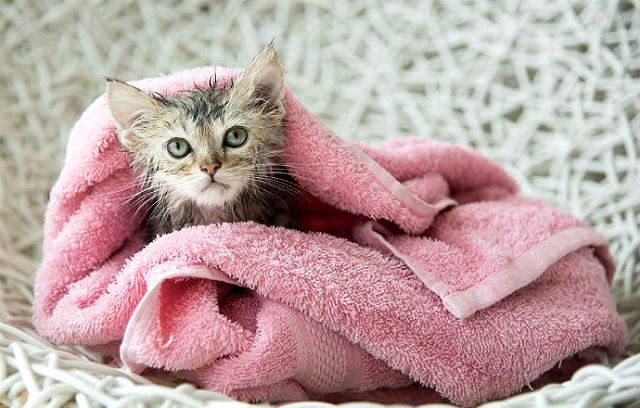
The expediency of bathing
Cats are very clean animals. They devote several hours daily to thorough licking. With the help of a rough tongue, pets are able to remove almost any dirt, as well as loose hair and skin flakes.
This desire for cleanliness has practical implications. Cats try to neutralize their own odor in order to sneak up on their prey while hunting.
The fear of water can also be explained. A wet pet is quickly supercooled, as it loses the ability to thermoregulate. Domestic cats living in "greenhouse" conditions have a rather weak immunity, which is not always able to withstand unfavorable factors.
If you bathe your kitten with aggressive shampoo, the protective lubricant will disappear, making the coat dry and brittle, and the skin will begin to flake off. Therefore, only special cosmetics are used for washing.
The kitten should be bathed when the following signs appear:
- the wool smells unpleasant;
- the skin becomes clammy;
- an abundant fatty coating appears;
- the kitten has fleas;
- dirt builds up in the folds of the skin.
Cats are bathed if they are heavily soiled. For example, in any chemicals, soot, oil. In this case, licking the fur will cause serious harm to the pet's health.
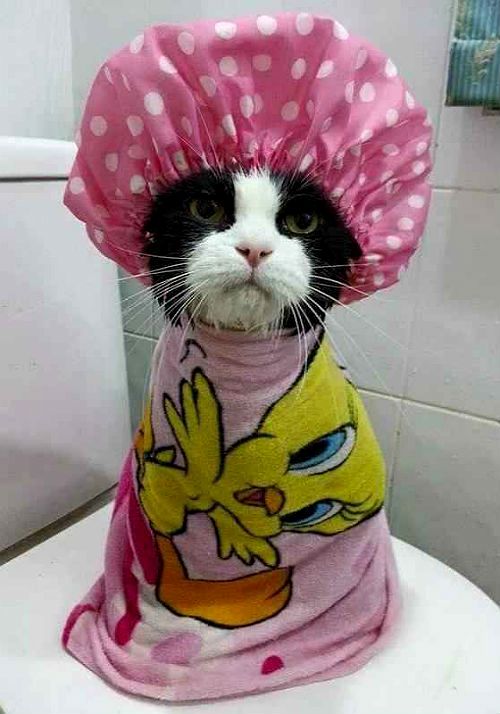

Preparation for bathing
So, the bath day is appointed. It is worth remembering the first bathing of the baby: the difference is small. It is necessary to prepare everything in advance:
- it is better to warm up the room if there is a heater;
- eliminate drafts;
- collect warm water for bathing and rinsing, the temperature should be within 37-40 ° C;
- prepare a towel (preferably two: the first will absorb moisture, the second can dry the wool).
Better to use some kind of capacity. The noise of a “waterfall” from a tap or “heavenly abyss” from a shower can plunge your pet into panic, and you will have to forget about a calm bathing.
Inventory
It is undesirable to bathe a kitten in the bath itself... Firstly, a huge space filled with water will terrify the baby. Secondly, in order for the baby to be calmer, he needs to cling to something. The edge of the basin will fit perfectly. It is impractical to use a sink for bathing: it is traumatic (the kitten can break free and fall from a great height) and inconvenient (splashes and puddles underfoot, of which there will be many, can play a cruel joke with the owner himself).
For the convenience of holding the escaping pet, you can use a harness leash. It will reliably prevent the baby from escaping. And for the more obstinate, you can purchase a special bathing bag. It is made of synthetic materials and has a coarse mesh structure. Equipped with a special cord for a secure fit around the neck. The use of such a bag will ensure swimming without bloody battles.
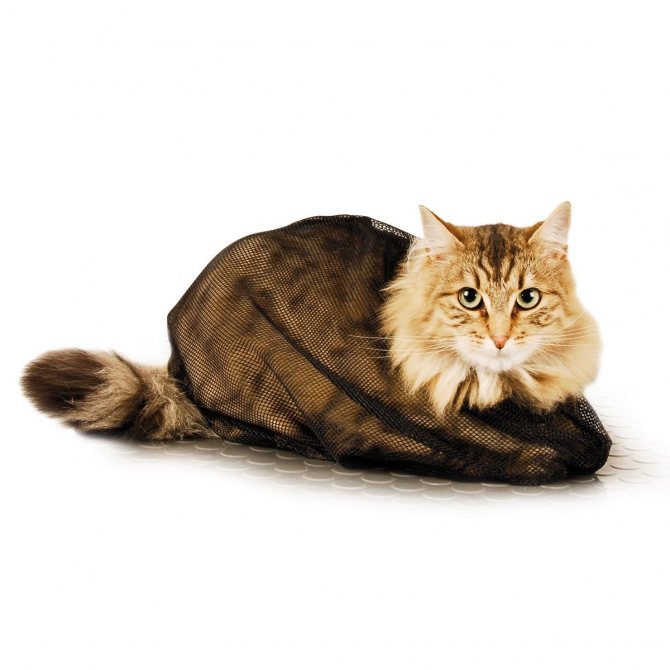

Water and detergent perfectly penetrate the large cells of the bag, but the pet is unlikely to be able to scratch the owner
This bag can also be used for other procedures, such as ear cleaning.
A washcloth for bathing a kitten is not needed. It is enough to carry out the procedure with your hands. Soft, gentle movements will soothe your baby.
While bathing, it is strictly forbidden to wash the cat's head. Water can enter the ears and cause serious health problems. To protect them, you can use cotton swabs or purchase a special bathing cap.
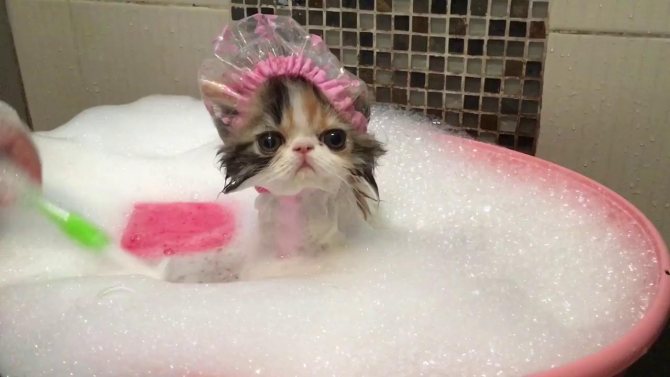

A bathing cap (replica of the one people use, only smaller) will prevent accidental water getting into your ears
Detergents
For bathing, you must use special products for kittens. It is not worth using shampoo for adult animals: the fatty lubricant in kittens is not yet sufficiently formed, and the acid-base balance of the baby's skin can be disturbed. Moreover, you cannot use shampoos for people, including children. The pH of the skin we have with cats is different, and such products can greatly dry out the epidermis of pets.
There are special shampoos designed for certain breeds, for example, for sphinxes or owners of luxurious long-haired coats. This also needs to be taken into account.
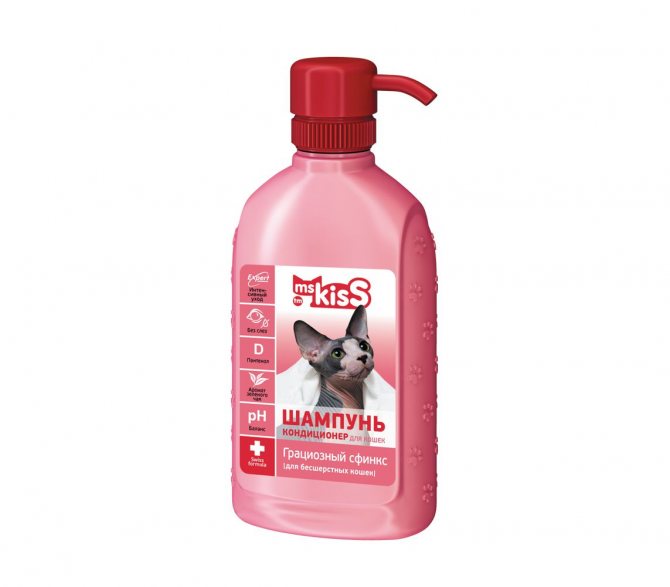

For some breeds of cats, for example, sphinxes, there are special shampoos
Types of special products for washing kittens
In addition to traditional liquid shampoos, there are also many alternative bathing products on the market, such as sprays and dry shampoos. This is a real lifesaver for those pets who are already very frightened by the water. Also, these funds can save you from unnecessary hassle if the pet is slightly dirty or in the absence of conditions for bathing (on the train, for example).
Dry shampoo is applied to a dry coat, spread over it and combed out. The spray should be applied to the damp coat, rubbed gently into the coat and removed by combing. These products are also good because they are suitable for frequent use and do not affect the fatty layer of the skin. The only problem that the spray can cause is contact with the eyes and the respiratory tract, so it should be applied without fanaticism.
Table: rating of popular and high-quality special products for bathing kittens (according to Yandex.Market data)
| Name | Manufacturer | Description | Price, rubles |
| Ms.Kiss "Fluffy Ponytail" | Russia |
| 150–200 |
| Shampoo for kittens 8in1 Tearless Kitten Shampoo | 8in1, Russia |
| 500 |
| Le Artis Herba Vitae shampoo with chamomile and coltsfoot extracts for kittens | Russia |
| 100 |
| Shampoo for kittens "Gentle" | Agrovetzashchita, Russia |
| 100 |
| Dry shampoo Ms. Kiss | Russia | Does not require rinsing | 450–500 |
Photo gallery: popular shampoos for kittens
Fluffy Ponytail contains biotin that soothes irritated skin, helps to get rid of flaking, strengthens hair from roots to ends. tidy pet hair
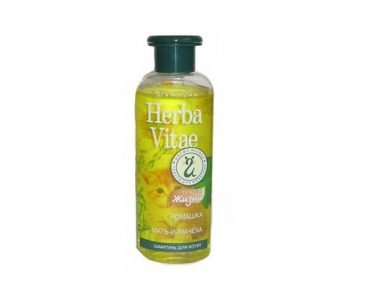

Herba Vitae is a Russian line of shampoos for dogs and cats, developed on the basis of natural ingredients
Contraindications to bathing procedures
There are situations when it is absolutely impossible to bathe kittens. These include:
- Disease - water procedures are abandoned until complete recovery.
- Vaccination - bathing kittens is prohibited for 14 days after vaccination.
- Ringworm - Water will spread the infection to other parts of the body.
- Operation - after surgery, cats are not bathed until the suture has healed.
- Severe stress - water procedures will only aggravate the condition.
First bath
The first time is the most important. If you can do everything right, do not scare the baby, and he will feel the pleasure of water procedures, you will save yourself from big problems in the future.
The most common mistake is to wash your kitten for the first time in the bath. Large, with a lot of water, it will surely scare the kitten. In addition, it will be very inconvenient for you to wash it on an incline, bending over the side and putting your hands down. Be sure that as soon as you hesitate for a second, the kitten will "fly" on your neck or on your head, climbing up your arms like a tree trunk.
The most convenient way to wash your baby is in a basin or sink. At the bottom, you need to put a rubber mat or a small terry towel. Water temperature should not be higher than 38 - 40 degrees, "depth" - no more than three centimeters.
It will be right if you prepare everything you need in advance: a large fluffy towel, shampoo, a bowl of water. If you have to wash the kitten alone (although it would be more convenient together), unscrew the shampoo plug in advance. Prepare a couple of cotton balls dipped in sunflower oil to plug them into your baby's ears, otherwise water may get into them. By the way, the eyes are protected by smearing their corners with vaseline oil.
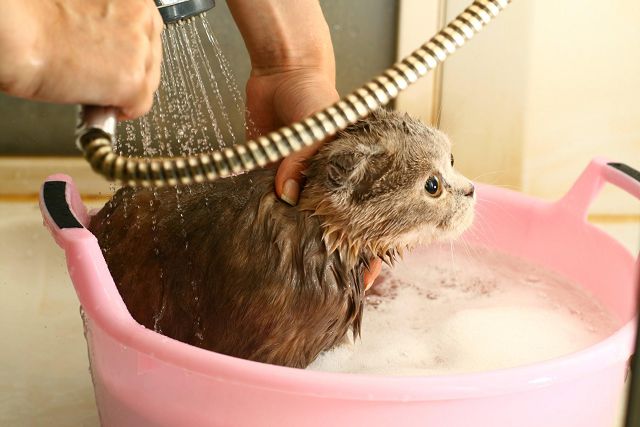

Prepared? Now the most important thing is how to bathe the kitten. Take it by the withers with your hand (as your mother-cat took it with your teeth) and sit it in a basin of water. Whether he will sit or stand on all four of his legs, it does not matter, the main thing is that his posture is sufficiently stable.
Wash your baby carefully, protecting your head (especially eyes and ears) from water. Do not turn on the shower - the strong pressure of the water can scare the kitten. Always talk to him in a normal, calm voice.
The bathing procedure should not be too long: the shampoo "eats" the grease from the hairs, and without it your pet's "fur coat" will not be shiny and smooth. And there is also the risk of overdrying the skin, which, because of this, will become an easy prey for harmful microorganisms and various infections.
After washing is over, wrap the pet in a towel so that it is comfortable for him to breathe and look around, in no case do not wrap his head up. Hold the baby in your arms for a few minutes to dry, and then lower him on the sofa - he will clean himself up. You will make sure that there are no drafts and your pet will not catch a cold.
And the last moment: praise the kid for being brave and obedient (you can even cheat a little) and reward him with something tasty that he really likes. For pedagogical purposes.
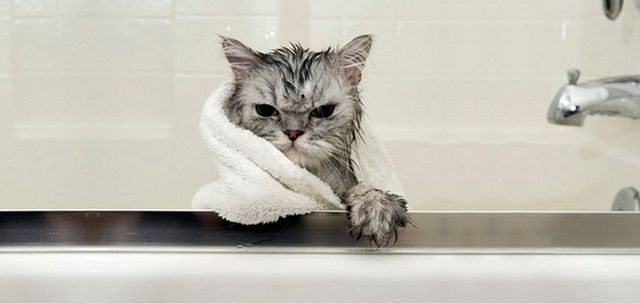

At what age can a kitten be bathed?
Kittens are more vulnerable than adult animals. Their immunity is still developing, so do not take risks and bathe your pet too early. During washing, the temperature regime is violated and the fatty film is washed off, which protects the baby from pathogenic bacteria.
There is no need to bathe kittens for the first 2 months after birth. The mother takes care of their hygiene. However, many breeders wash kittens as early as 1 month old. This is due to the fact that they prepare animals for sale and try to provide the most attractive appearance for babies.
In case of severe pollution, you can carefully wash a month-old kitten, but only if he is used to the owners and has got used to the apartment. If possible, it is best to limit yourself to wiping with a damp cloth.
At 3 months old, when the kitten gets stronger, you can start bathing it without harm to health. You should not postpone the procedure. The sooner the baby gets to know the water, the sooner he gets used to it.
As for the age at which you can bathe a kitten with flea shampoo, it largely depends on its brand. Usually, such drugs are not used for up to two months.
However, some mild flea shampoos can be used a little earlier. Beforehand, it is better to consult a veterinarian and carefully study the instructions.
Hygiene products for kittens
Before you wash your baby for the first time, you need to choose a detergent for him. The choice of these drugs in pet stores is large enough, but when buying shampoo for a pet, you should take into account the following nuances:
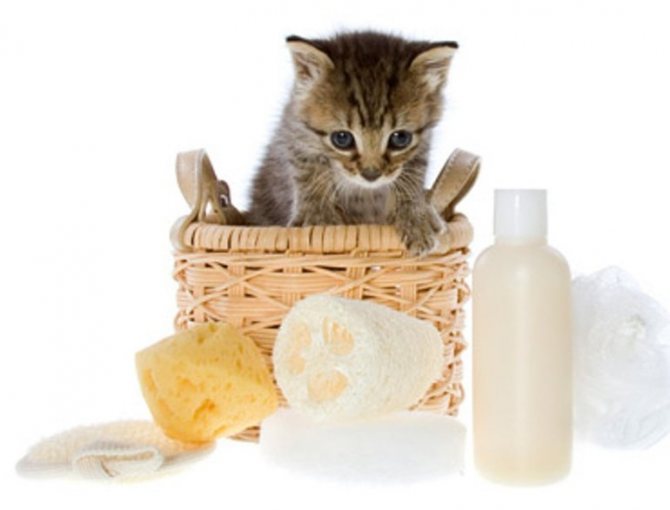

- Any, even neutral mild human shampoos, soaps used for children and allergy sufferers are not suitable for kittens or adult cats due to differences in acid-base balance. These household chemicals can negatively affect the animal.
- Do not use shampoos intended for puppies and adult dogs, rabbits and other pets to wash such babies.
- Do not use shampoos for adult cats, because babies' eyes, mucous membranes and skin are more sensitive and do not have sufficient natural protection.
There are special types of shampoos for kittens. Among them:
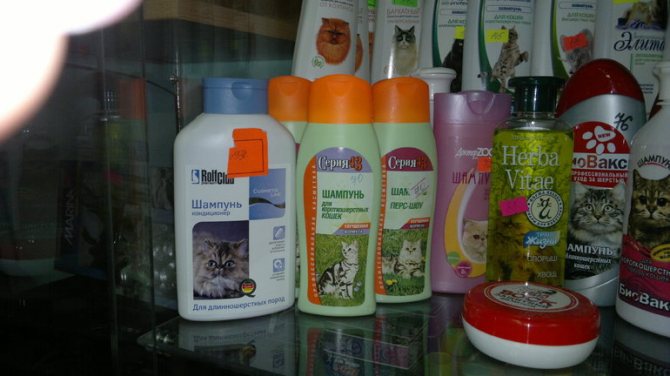

- Liquid. With their help, the animal's hair becomes soft and silky. For one use, a small amount of this product is required, since it gives a lot of foam, which is difficult to wash off.
- Dry. When a small pet is very afraid of water, then you can wash the kitten with dry shampoo (powder). This is a good way out of the situation, and although he will not be able to accustom the baby to water, in case of anxiety, such a remedy should be used. It cleans the fur of the animal as well as regular liquid shampoos. It is applied to the dry skin of the pet, and then with the help of a comb it is combed out of the fur along with the dirt. These shampoos are used for kittens over 3 months old.
- Spray shampoos. They are applied to wet animal hair and dry the skin to a lesser extent. This is especially important for pets under six months of age.
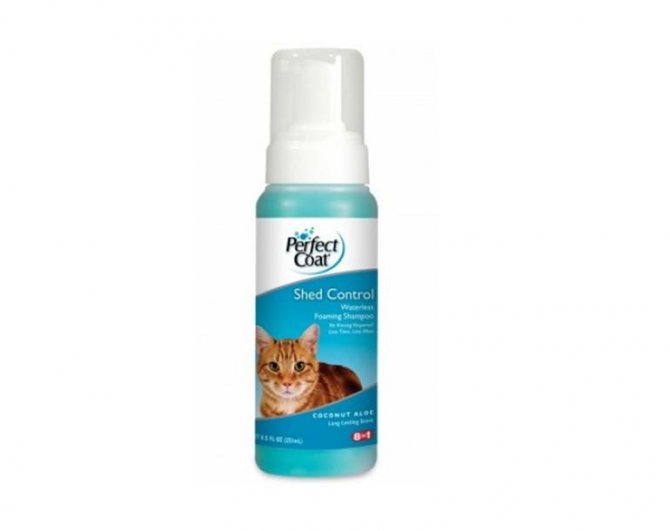

For thoroughbred kids, special shampoos are purchased. Such funds are developed taking into account the characteristics of kittens' fur, immunity and other indicators. The composition of a sphinx shampoo, for example, will be different from a British cat shampoo. Choosing such a detergent for a specific breed is optional, but desirable.
You should be aware that special shampoos used for kittens are quite expensive. And in order not to save on the health of your pet, you can choose domestic products that are not inferior in quality to imported ones. In addition, kitten shampoos can be sold in small bottles, which are cheaper than large bottles.
It happens that the kitten gets very dirty. Then he will definitely need water procedures.
How often to wash
Cats' natural love for cleanliness makes bathing an auxiliary rather than a basic hygiene procedure. On the contrary, washing the fur too often degrades the quality of the fur.
The frequency of washing kittens depends on the breed, coat length, health status. As a rule, cats are bathed 6 times a year. If the animal does not leave the apartment, bath days are spent once a quarter or six months.
Often only hairless kittens can be washed. They get dirty faster, so they are satisfied with water procedures about 1 time per month. Show cats are bathed unscheduled before the shows.
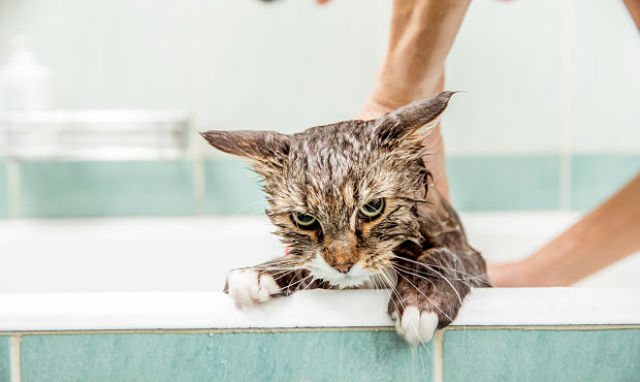

For your information. If a cat goes out into the street, after each walk, its paws must be washed.
Is it okay to bathe a cat or a cat in the heat?
It is believed that cats are extremely clean animals, so they do not need bathing at all. They say, if a little rabbit does not sleep, does not eat or does not play, he licks himself, tidies his fur. Partly true, healthy cats are always busy with the issue of their own hygiene. But it is imperative to wash animals living in the house, or, even more so, on the street.
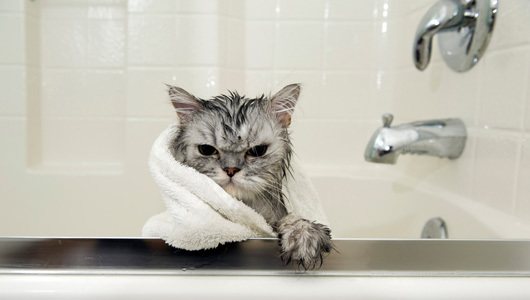

The domestic cat is bathed every 3 months.
It is necessary to bathe the cat if:
- He is wandering or taken home from the street, if he lives in the courtyard of a private house, goes outside for walks every day or during the "wedding season". If after the street the cat returns dirty, with matted hair, water procedures are equally needed by him and his owners. He's doing it himself quite well. But is it necessary that all this dirt gets into the digestive tract of the animal? And while he is soaking, the marks of dirty paws will remain in the house on the floor and on the furniture. For a child living in a house, contact with a walking cat is contraindicated until it is washed.
- If it gets dirty. A cat that has climbed into something sticky, inedible, or toxic needs to be bathed immediately before it starts grooming.
- If it sheds. During the molting period, cats lick themselves many times more often and more intensively, with their tongue they collect the fallen hairs from the fur coat. These hairs clog the stomach, and if they are not belched up, they cause the animal to experience discomfort and problems with stool, to refuse to eat. In representatives of long-haired breeds, intestinal obstruction may even occur. If you buy a shedding cat, it will be easier for him.
- If his undercoat is too dense. In this case, the cat cannot thoroughly wash itself.
- His coat is too greasy. This happens due to the peculiarities of the functioning of the sebaceous glands or due to illness.
- He has fleas. You will need to swim with a special antiparasitic shampoo.
- He is hairless. Hairless cats must be bathed once a week. By the way, many sphinxes and cats like them love to swim.
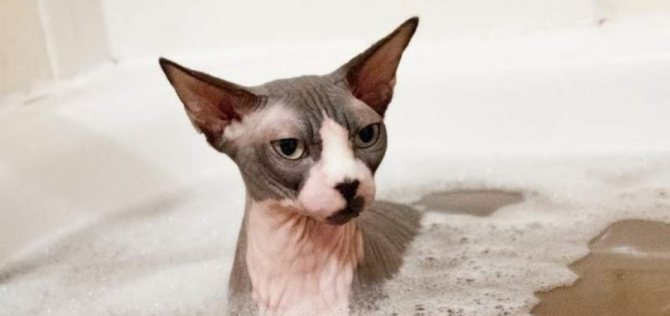

Hairless cats are bathed every 1-2 weeks.
Tar soap based on birch tar contains natural substances with disinsectant properties. It is believed that they can breed fleas in cats.
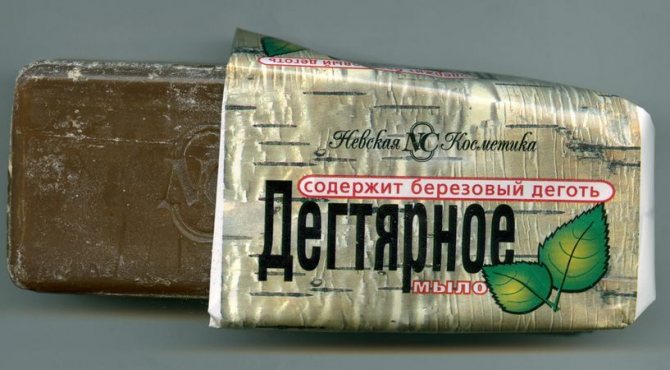

Tar soap is used for fleas in cats.
If, nevertheless, they decided to remove fleas from the cat with tar soap, this is done as follows:
- Prepare a soapy solution. 0.25 of soap is grated and completely dissolved in 200 ml of warm water.
- Moisten the cat's fur with plain warm water.
- The wool is treated with a solution of tar soap so that it gets on the skin. Thoroughly wash the folds of the paws, under the tail, neck and withers.
- The animal is kept in a soapy solution for 5-10 minutes.
- Thoroughly wash off the tar soap from the cat's fur.
- Repeat the procedure every 2 weeks as needed (flea eggs hatch in 2 weeks).
Cats of the British breed have a plush coat with a thick undercoat. She needs special care, which, in addition to good nutrition, taking vitamins, and regular combing, includes bathing every 2-3 months.
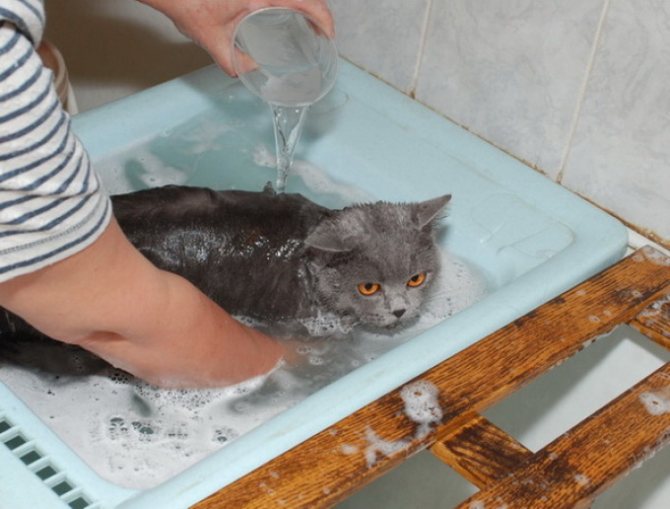

Cats - British need bathing.
Bathing the Briton in the bathroom. The fact is that it will be difficult to wash out all the shampoo from its undercoat in the sink or basin. If the cat is afraid of the noise of water, washing it out of a ladle or mug, at the same time you need to comb it out with a special brush.
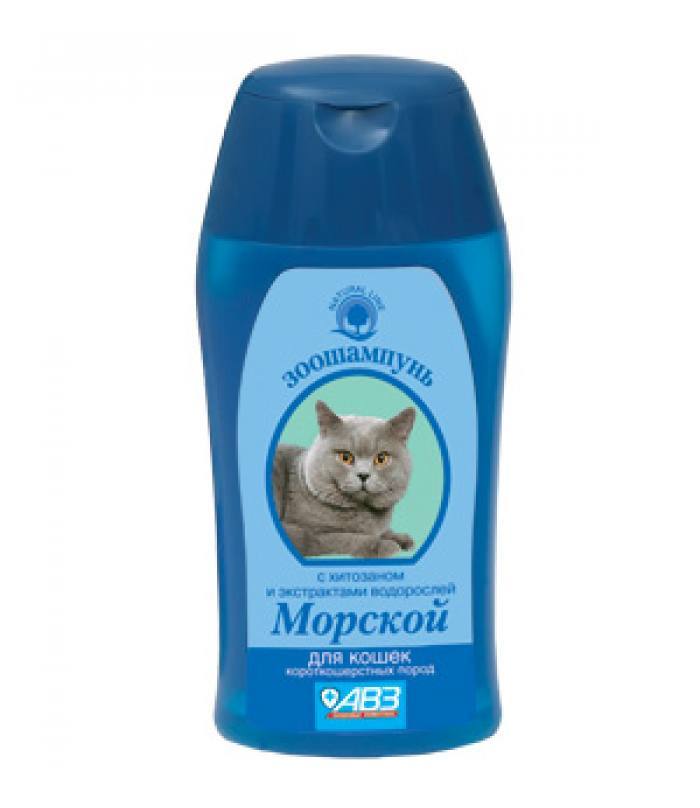

Shampoo for short-haired cats.
For bathing, you should get a special shampoo for the British breed.
If the cat suffers from heat in the apartment in the summer, the owners may want to bathe it in order to refresh it. But frequent bathing, as we already know, can be harmful. Therefore, "refreshing procedures" are recommended to be carried out as follows:
- place a wet towel within reach of the animal so that you can lie on it or wet its paws
- spray the cat with water from a spray bottle
- wipe the cat's head and paws with a damp cloth
And even in these cases, the water should not be very cold so that the cat does not catch a cold.
A reputable veterinary clinic gives a complete list of recommendations for owners of cats after castration and cats after sterilization. There should be a point about bathing. If there are no such recommendations, the general rule is not to bathe the postoperative animal for 2 weeks. A cat that walked past the tray after anesthesia and smells can be wiped off with a damp cloth, avoiding stitches and wounds.
You can bathe a cat during a difficult period of heat, the procedure will not harm her. Moreover, some owners noticed that after bathing their pets are so busy licking that they even calm down for a while. But this does not mean that water procedures can be arranged every day. They resort to them only once.
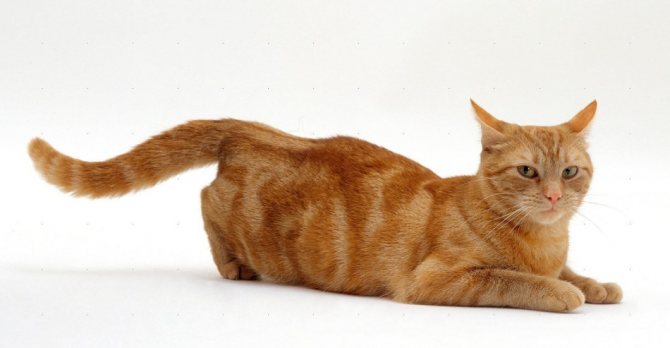

Bathing while in heat distracts the cat.
If the cat has an allergy that makes itself felt with itchy skin, bathing once every 5-7 days will help. Shampoos for such bathing should be as soft as possible, they are recommended by a veterinarian.
There is an opinion that a healthy cat does not need to be bathed, he will completely cope with hygiene on his own, but there are cases when the procedure is necessary:
- The cat was very dirty, the coat faded and fell into tangles.
- There are fleas or other parasites in the pet's coat.
- With lichen, dermatitis and other skin diseases.
- Favorite will participate in the exhibition.
Bathing helps the animals groom their fur and untangle mats. In addition, dust, dirt, filler particles accumulate on the wool when the kitten is just learning to go to the toilet.
What is required?
We wash my cat correctly and use it for this:
- Shampoo - fluffing, antiparasitic for removing fleas, or any other.
- A brace is a must have for a beginner in bathing. It is a collar with a rope, at the end of which there is a suction cup. Such a simple device will not allow the pet to jump out of the bath and hide under the sofa.
- Loofah-mitten or brush for washing. With their help, you can wash your coat well and get rid of parasites.
- Two towels. The first will dry the wool, and the second will warm it up.
- A hat, cotton balls or head pads - they are needed so that drops of water do not fall into the ears. This must be carefully monitored if I wash my cat. Water droplets can trigger an infection.
- Make sure that the soapy liquid does not get into the eyes of the animal.
For a cat and a kitten, there is one algorithm of actions:
- To do everything right, wait until your pet is no longer afraid of water. Then he will not break free, run away and bite.
- Move the animal to the basin, affectionately, without crying and force, hold it by the fold at the withers.
- Pour the wool from a dish or watering can.
- Dilute shampoo with water and apply to wet coat.
- Apply the product evenly in circular motions. Rinse the paws and anus especially thoroughly.
- Be careful with your tummy - this is your cat's weakest point.
- Rinse well with shampoo and wrap your pet in a towel.
How to wash your hair?
You don't have to take a bath to wash your cat's head. All actions can be carried out under the tap and remove all dirt from the head. Rub gently from the muzzle to the base of the ears.
How to wash your paws?
To wash the paws, you can put the animal in a basin and, without bathing it completely, wash off the dirt from the paws. If your pet is very afraid, you can wipe the paws with a wet towel. It is better to put the bowl not very far from the cat, so that you can reach and wet the towel several times.
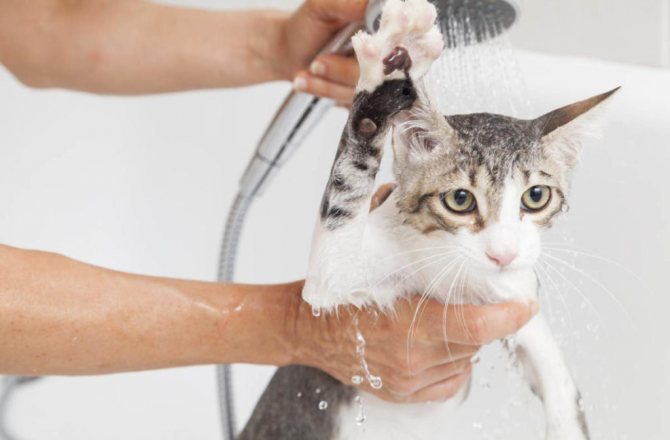

Bathing should take place in a comfortable temperature environment. The optimum water temperature is 39-40 degrees. If the indicators are lower, the animal will freeze, and if higher, this will affect the coat and skin.
The cat can be washed a few days after he comes into the house, so as not to cause additional stress. In addition, a sick animal should not be subjected to the procedure. If the pet has recently undergone castration or strip surgery, it is better to wait a while - at least 2-3 weeks.
Bathing a cat or cat is necessary only if there are good reasons for it. Indications for washing your pet:
- more than 2-3 months have passed since the last bathing, and the cat's hair has become dull, darkened, with tangles;
- the cat is very dirty, for example, it was lying in the mud or doused with paint;
- if parasites are found in the fur, you need to immediately bathe the cat, and then treat the "fur coat" with an antiparasitic agent.Especially carefully it is worth examining cats, which are often on the street and can "catch" ticks and fleas;
- washing can be recommended by a veterinarian if the cat has allergies, lichen, dermatitis and other diseases associated with the skin;
- if you find a kitten on the street and decide to take him into the house, then you cannot do without water procedures;
- in preparation for the exhibition, you will have to wash your cat with a special shampoo and make your pet “styling”.
Take the freshly washed cat to the room and pat dry with a towel. For short-haired cats, one towel will be enough, and for long-haired cats, do not regret 2-3 pieces. You can put your pet on a newspaper or hoe so that the dripping moisture is absorbed faster.
For your information: the cat has a so-called air cushion between the skin and the top layer of hair. This layer of air is heated by the heat of the animal's body and protects the cat from freezing. During bathing, the coat gets wet and temporarily loses its thermoregulatory feature, so it is so important to warm the cat with towels after washing and protect it from drafts.
We suggest that you familiarize yourself with: Black small spots in the mouth of the cat. Black dots in cats and cats: why and what to do. Burning the mouth in cats
How to wash a kitten
Kittens are bathed using gentle means. Shampoos are not suitable for humans - they are too aggressive.
Manufacturers produce cosmetics for a specific skin type:
- dry;
- oily;
- normal;
- damaged.
The most common are liquid shampoos and conditioners. They can include both conventional cleaning agents and special components. For example, to kill fleas, ticks and other parasites.
There are other types of cat shampoos:
- Dry shampoo - made in powder form. Contains absorbent ingredients: they remove excess sebum and dead skin flakes. However, it is unable to cope with heavy pollution. It is used as an express remedy for show pets or kittens that are afraid of water. Suitable for use in winter, as it avoids hypothermia.
- Spray Shampoo - Works in much the same way as dry shampoo. Moisturizes and conditions the coat and helps to get rid of tangles. A good option for partial bathing when you just need to freshen up your coat.
Some owners use a mixture of baby powder, cornstarch, or baking soda as a dry shampoo. However, this is quite risky. By absorbing moisture, the starch gives off gluten. If water gets on the skin, it will swell and stick to the fur.
Most likely, you will not be able to comb it out - the animal will still have to be washed. Soda must be carefully removed, otherwise the cat will be poisoned by eating it while licking.
Important. Better to bathe animals with industrial dry shampoos. For example, brands Trixie Trocken and Mr. Gee.
When choosing a detergent, the following points should be taken into account:
- Short-haired, long-haired and hairless kittens are bathed with shampoos from separate lines.
- You should buy shampoos designed specifically for cats or at least for cats and dogs. However, some show cosmetics are only available for dogs. It is used in extreme cases.
- Concentrated shampoos are more expensive but more economical. Before use, they must be diluted with water according to the instructions.
The most popular cosmetics with which you can bathe a kitten are presented in the table.
| Effect | Name |
| Against parasites | "Disinfectant" (Bioflor company); |
| Lugovoy (Agrovetzashita); | |
| "Tar" (celandine); | |
| "Doctor ZOO" | |
| Curative | The Doctor (Goodman); |
| "BioVax for kittens"; | |
| Beaphar Shampoo Anti Dandruff | |
| For damaged skin and coat | Iv San Bernard Zeolithe |
| Strengthening and restructuring of wool | YuuP! Professional Restructuring & Strengthening; |
| Tropiclean Lime / Coconut | |
| For the regulation of shedding and against mats | FURminator spray; |
| Perfect Coat Shed Control & Hairball (8 in 1); | |
| Phytoelite (Veda) | |
| Caring | Iv San Bernard Atami (antistatic); |
| "Tender", "Marine" (Agrovetzashchita); | |
| Velvet (CrystalLine); | |
| Artero 4Cats | |
| To add volume | Anju beaute texture volume |
Important. The kitten may be sensitive to any component of the detergent. Therefore, after bathing, you need to monitor the condition of the baby. If you have an allergy, you should contact your veterinarian.
How to wash your cat properly
They may differ in the form of release, as well as in their state of aggregation. Shampoos can be:
- Dry. In the form of free-flowing powders.
- Classic. That is, such as in people that need to be applied to wet wool
- Spray shampoos. This is a new species that does not contain moisture, so there is no need to wash your cat before shampooing. You don't need to wash it off either.
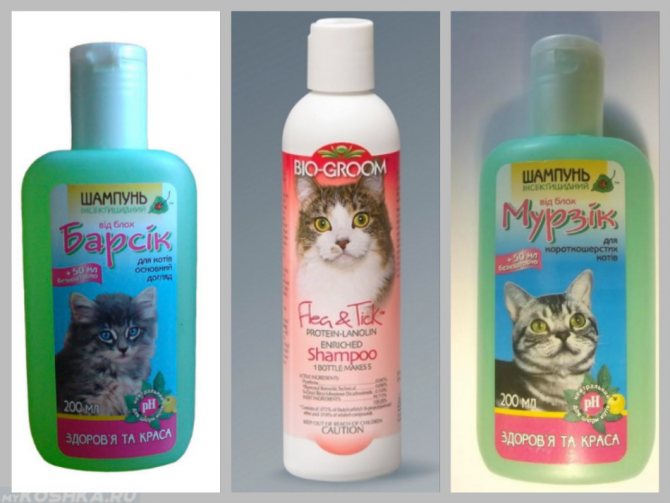

Shampoos for a cat
Purpose of shampoos:
- By their action, shampoos can be cosmetic. Used only if it is necessary to remove dirt from your pet's fur.
- Medicinal. These types of shampoos are also classified into several types, depending on the problem. There are shampoos for lichen, fleas, as well as for bacterial lesions. Remember that flea shampoo contains an insecticide, so such products cannot be considered completely safe. Carefully monitor your pet to avoid getting the product in your eyes, ears or mouth. Because this can provoke poisoning of the animal. Lichen shampoos are also often used. They contain antifungal drugs that help fight rashes.
- Antibacterial shampoo, most often contains an antiseptic. In the case of a cat, most likely it is Chlorhexidine or Miramistin. The tool allows you to get rid of a bacterial infection in a short period of time.
- In addition, there are special shampoos that can tone your pet's coat. That is, you can separately purchase shampoo for white and black cats. They help to give a beautiful color to the coat, as well as take care of it. Please note that toning shampoos cannot be used before visiting the exhibition. Because your cat could be disqualified.
Shampoos for a cat
Please note that under no circumstances should human shampoo be applied to the skin of hairless cats. That is, these are sphinxes, as well as Egyptian breeds, which have practically no hair. The fact is that their skin is very sensitive to various substances, and dries out very much when exposed to ordinary shampoo.
For such cats, special products have been developed that allow you to moisturize the skin and form a protective silicone layer on its surface, which prevents the penetration of microorganisms, as well as skin peeling.
We suggest you familiarize yourself with: How to choose vitamins for cats and cats
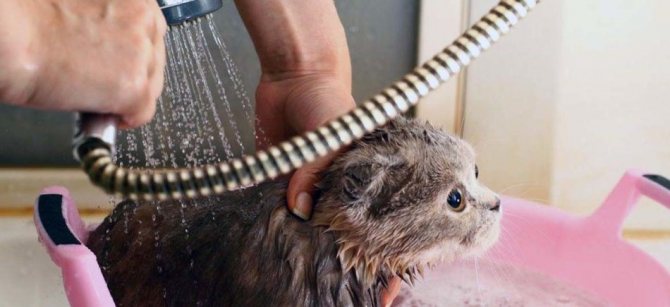

Bathing a kitten
List:
- Shampoo Dr. This product contains benzoyl peroxide, which has antifungal, antiviral, and antibacterial properties. Thanks to this, it gets rid of dandruff, and also prevents the occurrence of lichen in the cat. Can be used for cats of all breeds.
- Elite shampoo. This option only applies to hairless cats, that is, hairless. The composition contains many herbal extracts: thyme, eucalyptus, which help to regulate the secretion of sebum, and also prevent the skin from drying out. Forms a kind of film on the surface that protects the sensitive skin of the pet.
- Perfect coat. An excellent product that reduces hair loss. Best of all prevents the formation of tangles in the pet's stomach. In addition, the shampoo is anti-allergenic and can be used to bathe pets with allergies.
- Jerob shampoo.This is a professional tool that is mainly used to prepare pets for exhibitions. Helps to improve the condition of the coat, makes it fluffy, smooth and shiny. The cost of the shampoo is quite high, so if you have a regular pet that does not participate in exhibitions, there is no point in purchasing this shampoo.
- Rolf Club. This is a whole line of cat care. The fact is that the composition of these shampoos can contain completely different components. The line consists of shampoos for long-haired breeds, short-haired, as well as with a therapeutic effect. They help get rid of lichen, fleas, and a variety of bacterial lesions. Prevents the formation of dandruff, as well as excessive drying of the skin of the cat. Choose the type of shampoo based on your cat's breed and the specific problem.
- Biovax shampoo. Contains Lanolin in its composition, which prevents the pet's skin from drying out. That is, the hairs are covered with natural wax, which gives the coat a shine, as well as a healthy look. Almost all animals do not have an allergy to this agent, because there are very few allergens in the composition.
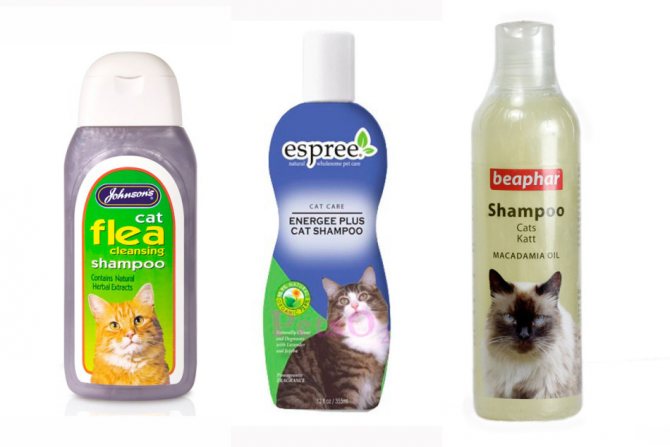

Shampoo for cats
For bathing, it is best to purchase shampoos at a veterinary pharmacy, or special pet stores. They differ in a special composition, and absolutely do not dry the cat's skin.
Until the water has cooled down, and the cat has not suspected something was wrong, grab it and carry it to the bathroom. Talk to the purr affectionately, do not make sudden movements that could scare your pet. Do not forget to close the door - if it escapes, it will be difficult to catch the cat, and wet footprints will remain throughout the apartment (possibly together with foam if you have time to soap the cat).
Place your cat gently in a tub, basin, or sink. During the dive, you can hold it by the scruff of the scruff so that the pet does not break out and scratch you. Put on a bathing cap or put cotton swabs in its ears. Water the coat with warm water, avoiding contact with eyes, nose and ears.
It is likely that the cat will be unhappy and will start to resist. She'll have to be persistent - for her own good. Place the shoulders of the cat directly under the chest in your left hand if you are right-handed. Thus, the dominant hand will remain free, and with its help it will be possible to soap the animal. If the cat is waving its hind legs, then you just need to sit it down and hold it so that it cannot jump and kick.
At this stage, the assistant will greatly facilitate your task - he can water the cat from a watering can or shower, serve shampoo, a towel and other necessary items, and you will do all the manipulations with your free hand.
Note: pet stores suggest using a short leash with suction cups for bathing your cat. It makes sense to use this accessory only as a last resort, since the pet can be afraid of the leash more than washing, and in the future it will be difficult to lure the cat for water procedures.
Now lightly massage the shampoo onto the wet cat hair. Lather your back, chest, belly and tail consistently, do not forget about the legs and chin. Do not use too much shampoo, so you don't have to rinse off the lather for a long time.
Use a washcloth to gently wash the cat's face. If you want to wash the cat's head, ask the assistant to cover his ears or put cotton swabs in them. Also, be careful not to get water in your cat's nose.
It's time to thoroughly rinse the cat's fur. Rinse off the foam from top to bottom. It is convenient to rinse off the shampoo with a hand shower, just do not lift it very high. Do not leave any residual detergent on your cat's skin, as this can cause irritation later on.
If you rinse your pet with a pelvis, consider the length. For a short-haired cat, one basin will be enough, while for a long-haired cat - several.
Important: you can not wash the cat after feeding and immerse it in water with its head.
When the shampoo is washed off, take the purr out of the water, wrap it in a large towel and hug your "cocoon" for a few minutes. The cat should come to his senses and calm down.
- The shampoo you are using is definitely not suitable, as the felines have a different pH.
- The product must be hypoallergenic.
- Buy kitten products only in special stores, to be sure of the quality of the purchased product.
- It is important that the bath product has a low foam level, cleanses and adds volume and shine.
- Veterinary seaweed shampoo is especially good for the first bath. The British are bathed a little differently (like bathing a British kitten).
- The best option may be dry shampoo or spray shampoo, as they are the most convenient for use (can you wash your kitten with regular shampoo).
Specialized products for bathing animals are quite expensive, but you should not save on the health of your family member.
It is worth paying attention to the direction of action of each product that you are going to use.
| Focus | Application features |
| For volume and thickness of the coat | A classic product suitable for animals of all ages. |
| For kittens from 2 to 6 months | Use according to the age of the animal. |
| Shampoo for sensitive skin | Hypoallergenic agent. |
| Specialized shampoo for cat show | The product is intended for special use. |
| Flea remedy | Before use, be sure to read the instructions. |
How to properly bathe a kitten for the first time
If you bathe a small kitten correctly for the first time, he will not have negative associations with this procedure. Therefore, it is so important that washing is as comfortable as possible.
Felinologists recommend adhering to the following rules:
- Do not bathe your cat after eating. Allow only a light snack, but it is better to wash your pet on an empty stomach.
- It is advisable that the kitten's bathing occurs during the molting period. Washing will make the process easier, and the animal will not accumulate a lot of fur in the stomach.
- Before bathing the pet, the fur coat is carefully combed, tangles are unraveled. To prevent the kitten from scratching, it is advisable to shorten the claws.
- The bathroom should be protected from drafts.
- To wash your kitten for the first time, it is best to use an unscented shampoo.
- The first time it is better to bathe the kitten with an assistant. One person will hold the baby, the other will perform the necessary manipulations.
- The water should not be too cold or hot. The optimum temperature is + 38 ... + 40 ° C.
- The auricles are plugged with cotton so that no water gets into them. If this happens, inflammation can develop.
- It is better to moisten the head not with a stream of water, but with a damp sponge.
It is recommended to wash the kitten for the first time not in the bath itself, but in a small basin. This will make it easier to hold, and the pet will feel more confident. To prevent the paws from slipping, a rubber mat is placed on the bottom of the container.
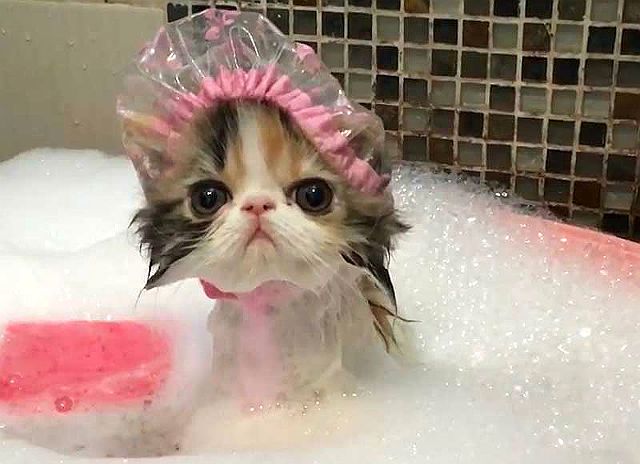

For your information. Bathing the kitten in the sink is undesirable. He can break free, fall from great heights and be injured.
All necessary equipment - detergent, towels, treats, etc. - should be at hand. If your pet scratches a lot, you should take care of rubber gloves. They will protect your hands from sharp claws.
When all the preparations are completed, the kitten is gradually immersed in water approximately shoulder-length. You can allow him to hold on to the edge of the basin and pour water at the same time. In order to bathe the pet without frightening him, in the process they talk to the baby in an affectionate voice. A benevolent intonation makes it clear that there is no threat.
Shampoo is diluted in a separate container in the required concentration and applied to the kitten's body. The soap solution is gently distributed with massaging movements, trying not to wet the head. Particular attention is paid to:
- armpits;
- stomach;
- areas around the genitals;
- paws;
- places behind the ears.
More dirt accumulates here.If the pet is bathed with an antiparasitic agent, the neck is first treated to prevent fleas from escaping onto the head.
The shampoo is left on the coat for the time specified in the instructions, and after that the kitten is rinsed with plenty of water. It is better to water the baby from a mug or moisten the wool with the palm of your hand than to use a tap or shower - the powerful jet will scare the pet.
At the end, the fluffy is generously praised and treated to a favorite treat to consolidate positive associations.
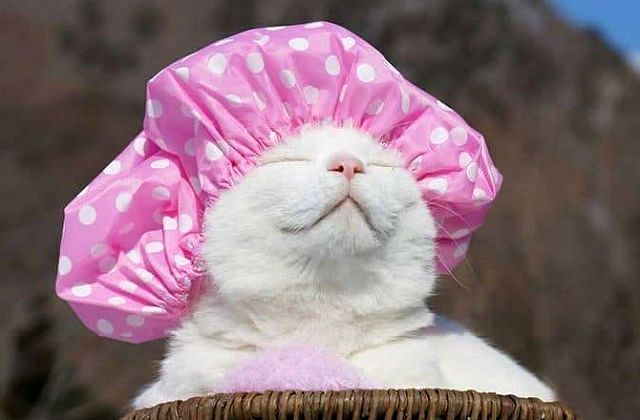

How to wash a cat
How to effectively wash a cat from fleas? Very often, owners of small kittens are not advised, in principle, to use store preparations, since if the product contains aggressive chemicals, this can significantly affect the well-being of your pet. Nevertheless, the main thing is to take seriously the choice and purchase of the drug. If you use a high-quality and at the same time mild shampoo (designed for bathing small kittens), you can achieve a full result without harming your pet's health.
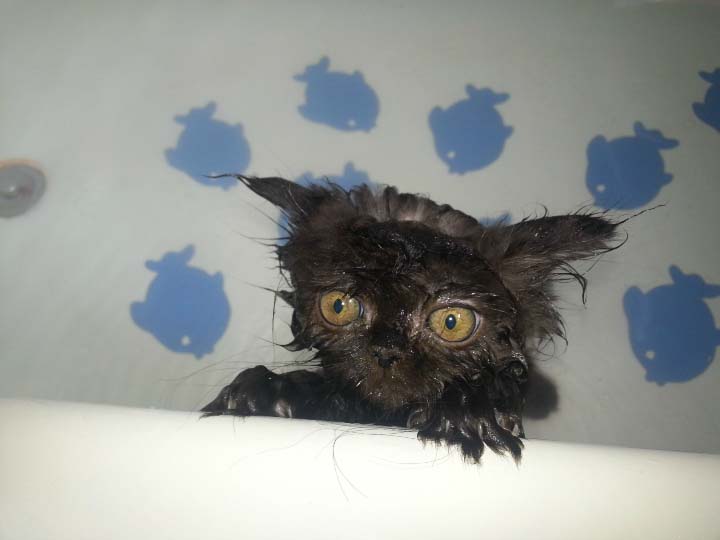

How to shampoo a kitten:
- in order not to get your clothes dirty, wear an apron or just wear something that is not scary to get wet or dirty;
- wash the kitten with lukewarm water;
- hold your pet over a bowl and pour water on it, starting from the head and towards the tail. At the same time, try to do it carefully so that soapy water does not get into the eyes or ears of the kitten;
- apply a small amount of shampoo to your hand and then rub it into the fur of the animal with smooth movements so that the preparation penetrates to the skin itself;
- after you have soaped your cat, rinse the fur thoroughly with clean warm water. Repeat the procedure if necessary.


After bathing the kitten, dry it with a towel. A hairdryer is not a very effective assistant in this matter, since furry pets, as a rule, are afraid of its noise. And of course, don't forget to treat your kitten with some goodies.
How to wash representatives of different breeds
Representatives of different breeds require a special approach to bathing:
- Short-haired Scots and Britons, who devote a lot of time to grooming, can be bathed once every six months.
- Long-haired cats, such as Persian or Siberian, are washed every 2 months.
- White kittens are bathed with bleaching shampoos.
- Detergents for long-haired breeds are not used for short-haired kittens with abundant undercoat.
- It is undesirable to bathe kittens of white and blue colors, partikolors and silver pets with herbal shampoos.
- To wash sphinxes and other hairless cats, use specialized shampoos that care for the skin. The head is wiped with sanitary napkins.
- Volumizing products are not suitable for animals with tight-fitting hair without undercoat (Siamese, Oriental, Abyssinian, etc.).
How to train a kitten to swim
Bathing is stressful for your pet. To avoid health problems and not injure the psyche of the baby, you need to prepare it before the first wash.
Important. Kittens have a subtle sense of people's mood. If the owner is nervous, the excitement will be transmitted to the pet. Therefore, before swimming, you need to calm down and relax.
First, they put the kitten in a dry bath and try to play with it. He needs to understand that it is safe here. When the baby is comfortable, the tap is opened. Some pets themselves show interest and begin to indulge in a thin stream of water.
The process is repeated several times until the kitten is absolutely calm about the procedure. Cats that cannot get used to the water can be bathed in mesh bags. They restrict the movement of animals, but do not interfere with the ingress of water and detergents on the body.
Bathing the cat before the show
Before participating in an exhibition, any domestic cat will have to be washed. Such bathing will have some peculiarities:
- you need to wash the cat before the show 2 times, with the second soaping, a tint shampoo (or balm) is used, selected depending on the color;
- the foam is also washed off 2 times, first with water, then with a rinse aid or a weak solution of vinegar;
- during drying with a hairdryer, the wool is smoothed with a massage comb with an antistatic coating of teeth, starting from the back and ending with the collar;
- now on the still slightly damp "fur coat" you can apply powder, which will absorb the remaining moisture and make the coat smooth;
- After a couple of hours, finish treating your cat's coat with a protein conditioner.
White pets are washed 2 or even 3 times with shampoo intended for white cats. When reapplying, leave the shampoo on for 2 minutes for a deeper effect, then remember to rinse well. White shampoo is also suitable for chinchilla and silver marble cats, but you don't need to leave the detergent on the coat. If a creamy, blue, or purple cat looks dark to you, use the same shampoo for a lighter, brighter shade.
Cats with rare red, tortoiseshell and marbled red colors should be washed with red or bronze shampoo. If the cat has a chocolate coat, add a few drops of black to the bronze shampoo. Black shampoo is suitable for fluffy beauties of black colors.
Follow the instructions and your cat will outshine all of its relatives at the show!
How to dry
After bathing, wipe the pet with a terry towel and wrap it in a soft cloth. It is not worth rubbing the fur diligently - it will become very tangled.
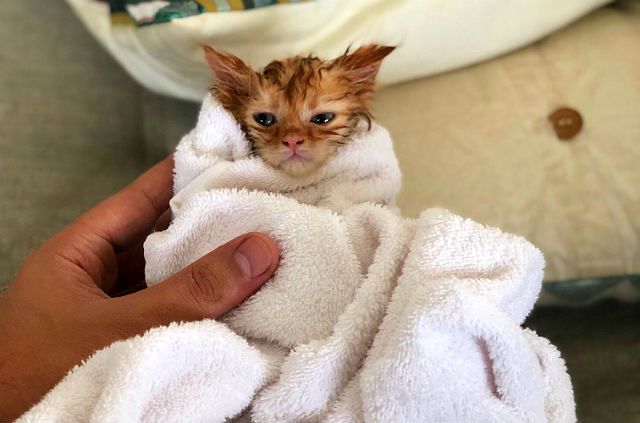

Then the kitten is released. He begins to actively lick and dries the fur coat on his own. A rough tongue combes the hairs and evenly distributes protective lubricant over them.
If your baby is shaking for more than 5 minutes after bathing, you should use a hairdryer. The same applies to long-haired breeds. However, the baby must first be introduced to this device, otherwise he will be frightened. The air flow should be warm, but not hot. During the drying process, the fur is combed in the direction of hair growth.
Important. Within 12 hours, the kitten should be in a warm room without drafts and not go outside.
If you bathe the kitten correctly, he will not be afraid of water in a panic. It is important to teach your baby to hygiene from childhood and to use suitable detergents - then the procedure will not cause much trouble.
Can a cat get rid of fleas by bathing?
Regular anti-parasitic shampoo will not get rid of fleas. The success of treatment depends on both the treatment of the infected animal and the treatment of the environment with insecticidal preparations. There are always more fleas in and around the litter than on the animal itself.
Now, shampoos containing insecticides have begun to appear. They can wash adult cats, but not kittens! After you wet the skin of the animal, rub the shampoo vigorously into the fur for 5 minutes, keeping it out of the eyes and mouth. Then wait for the time indicated on the label (it depends on the ingredient used), and then rinse off with running water from the shower for at least 5 minutes so that no soap remains on the skin. Otherwise, the shampoo will enter the cat's stomach while she licks the skin. It is often helpful to wash your cat with this product before spraying it with powder or parasite spray.
There are also solid soaps that contain antiparasitic substances, but they are more difficult to use and, since it is better to leave the soap without rinsing it off the coat to increase its effectiveness, there is a danger that the cat will ingest the insecticide. If anything, bar soaps are less effective at fighting fleas than shampoo.
I would like to clarify a few more points. Bathing even with shampoo does not guarantee that the cat will get rid of fleas forever.Many of them will jump off the animal while bathing and may well jump back after the end of the procedure. Even if, you manage to destroy them, there are too many insects around, which are just waiting for the opportunity to take a free space. In addition, fleas are very mobile, and it is impossible to get rid of them by combing the fur. The only thing that combing can help is to identify the presence of fleas and their larvae.
Bathing your cat and treating its litter with a disinfectant solution will not get rid of fleas. Disinfectants, in fact, are not intended for this. Most flea eggs will easily tolerate cleaning carpets and floors with any disinfectant. Recommended for home use pine oil disinfectants (they may be sold under different names) are relatively ineffective, and are not considered serious remedies by medical hygienists. Other antiseptics (skin disinfectants) that are recommended for cleaning wounds are also not very effective against most organisms. Most likely, these substances will not help you in the fight against fleas, but will only scare the cat with their smell or lead to skin irritation or digestive upsets.



